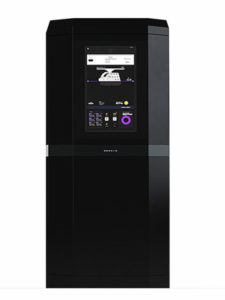Here’s a new way to use the capabilities of 3D printing. This machine uses DLP 3D printing technology to create a hollow shell mold, which is then injected with a plastic material or metal powder.
The material in the mold hardens, the mold is immersed in a warm bath until the shell melts away, and you have your part.
Startup company Collider makes this machine, known as Orchid. The goal is to find a way to speed the development of tooling.
Orchid uses DLP 3D printing technology to “3D print” the hollow shell.
The material used inside the shell is standard off-the-shelf material (rubber, silicone, metal or a polyurethane) that Colllider makes available in cartridges.
Metal powder is usually combined with a binding resin. Parts made from this material would be sintered in a furnace to remove the binder and solidify.
Collider calls this process Programmable Tooling. As with other 3D printing technologies, it can speed up the design process, enabling engineers to obtain parts in a few hours rather than days or weeks.
Plus, because it works with off-the-shelf materials, engineers can use the material they want as long as it can be injected into the shell.
The Orchid can be used in offices or labs. The quality of the built parts are said to be on par with injection-molded parts.
Motion control components, including stepper motors are helping to deliver that quality.
Depending on the user, the Orchid may need to operate 24/7.
To ensure the printer can meet such a demand, Collider engineers chose to use the STM24 Integrated Stepper motor from Applied Motion Products to drive the main print axis.
The motor’s function is to ensure smooth, accurate motion of the main axis.



